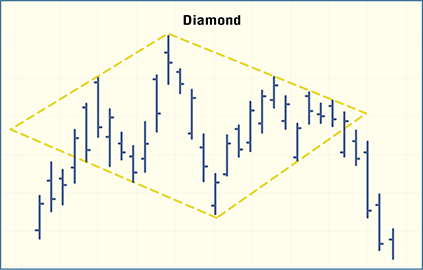Macacos me mordam...
6 mensagens
|Página 1 de 1
Pois, desobri um link que o patdav aqui tinha deixado e que explica isso. Ainda por cima bate certo com a situação actual, né?
http://www.traders.com/Documentation/RE ... amond.html
The diamond formation reversal pattern is found relatively infrequently. When it does form, however, it usually does so at market tops rather than at bottoms. This is consistent with its appearance, which suggests a confused, active market found at a top more often than at a bottom. As Figure 1 shows, the diamond starts off as a broadening formation and then consolidates, usually forming a symmetrical triangle. The combination of price patterns first broadening and then consolidating gives the geometry for which the diamond is named. This shape becomes more apparent when trendlines, like those shown, are drawn connecting successive peaks and valleys. The shape has also been described as a complex head and shoulders with an odd center movement.

FIGURE 1: DIAMOND FORMATIONS. This reversal pattern, which is found relatively infrequently, usually shows up at market tops rather than market bottoms. This is consistent with its appearance which suggests a confused, active market found at a top more often than at a bottom.
Volume activity can help distinguish a diamond from an ordinary head-and-shoulders formation. The tendency might be to see a formation and interpret it as a diamond, when in reality it is only a head-and-shoulders pattern. This bias toward the diamond might be because an upsloping neckline would allow an earlier entry of the position and therefore more potential profit. A genuine diamond pattern is signified by a decrease in volume during the second half of the price pattern.
This volume pattern is similar to the one found in a standalone symmetrical triangle. When a diamond forms at a top, the following downmove is usually significant. A minimum expectation of the move can be estimated by measuring the distance in points at the widest part of the diamond. Prices usually move from the breakout price to a low, giving a net change at least equal to this measurement, typically further.
http://www.traders.com/Documentation/RE ... amond.html
The diamond formation reversal pattern is found relatively infrequently. When it does form, however, it usually does so at market tops rather than at bottoms. This is consistent with its appearance, which suggests a confused, active market found at a top more often than at a bottom. As Figure 1 shows, the diamond starts off as a broadening formation and then consolidates, usually forming a symmetrical triangle. The combination of price patterns first broadening and then consolidating gives the geometry for which the diamond is named. This shape becomes more apparent when trendlines, like those shown, are drawn connecting successive peaks and valleys. The shape has also been described as a complex head and shoulders with an odd center movement.

FIGURE 1: DIAMOND FORMATIONS. This reversal pattern, which is found relatively infrequently, usually shows up at market tops rather than market bottoms. This is consistent with its appearance which suggests a confused, active market found at a top more often than at a bottom.
Volume activity can help distinguish a diamond from an ordinary head-and-shoulders formation. The tendency might be to see a formation and interpret it as a diamond, when in reality it is only a head-and-shoulders pattern. This bias toward the diamond might be because an upsloping neckline would allow an earlier entry of the position and therefore more potential profit. A genuine diamond pattern is signified by a decrease in volume during the second half of the price pattern.
This volume pattern is similar to the one found in a standalone symmetrical triangle. When a diamond forms at a top, the following downmove is usually significant. A minimum expectation of the move can be estimated by measuring the distance in points at the widest part of the diamond. Prices usually move from the breakout price to a low, giving a net change at least equal to this measurement, typically further.
Apesar de polémico (é uma figura relativamente «recente» e não costuma ser incluída nas figuras clássicas que já são consideradas há muito mais tempo como H&S e etc), o <i>diamond top</i> é uma figuras relativamente eficaz (com uma taxa de falhanço relativamente baixa) segundo alguns estudos.
Tende a formar-se após subidas bruscas (como parece ser o caso do gráfico da Marta), formando uma espécie de consolidação, não em rectângulo, bandeira ou pendão mas em forma de losangulo. Se vista como uma consolidação algo «excentrica» a figura faz sentido e acaba por não ser muito diferente das outras (em teoria).
Tende a formar-se após subidas bruscas (como parece ser o caso do gráfico da Marta), formando uma espécie de consolidação, não em rectângulo, bandeira ou pendão mas em forma de losangulo. Se vista como uma consolidação algo «excentrica» a figura faz sentido e acaba por não ser muito diferente das outras (em teoria).
FLOP - Fundamental Laws Of Profit
1. Mais vale perder um ganho que ganhar uma perda, a menos que se cumpra a Segunda Lei.
2. A expectativa de ganho deve superar a expectativa de perda, onde a expectativa mede a
__.amplitude média do ganho/perda contra a respectiva probabilidade.
3. A Primeira Lei não é mesmo necessária mas com Três Leis isto fica definitivamente mais giro.
Il Target del diamond si ottiene misurando l'ampiezza della figura e proiettando il valore così ottenuto sul breakout. Normalmente il diamante, trovandosi nelle fasi topping di mercato caratterizzate dalla improvvisa ed irrazionale fase frenetica (broadening) a cui segue una pausa di riflessione (triangolo) può rappresentare una inversione del trend, più che una sua continuazione.
Nella figura 8, che rappresenta l'indice DJIA, il grafico dopo la sosta nel diamante esce dalla parte superiore della figura, facendo ipotizzare la continuazione del trend.
Nella figura 8, che rappresenta l'indice DJIA, il grafico dopo la sosta nel diamante esce dalla parte superiore della figura, facendo ipotizzare la continuazione del trend.
- Anexos
-
- Image1.gif (54.46 KiB) Visualizado 1043 vezes
- Mensagens: 23939
- Registado: 5/11/2002 11:30
- Localização: 4
Esse diamante (padrão técnico muito polémico e com o qual eu não concordo nada) que tentas descortinar não me parece válido, pois um diamante, por definição, é uma figura técnica que demora muito tempo a ser formado (longos meses), pelo que não me parece que possas considerar isso um diamante.
Beijos,
Ulisses
Beijos,
Ulisses
Macacos me mordam...
Macacos me mrodam se isto não é um diamante "à la ed downs..."
Não parece?
Qual é o target de uma figura dessas? não é a altura?
Não parece?
Qual é o target de uma figura dessas? não é a altura?
- Anexos
-
- ndx.png (2.43 KiB) Visualizado 1101 vezes
6 mensagens
|Página 1 de 1
Quem está ligado:
Utilizadores a ver este Fórum: aaugustobb_69, cali010201, Goldendust, Google [Bot], Google Adsense [Bot], jcpequeno, Lisboa_Casino, PAULOJOAO, Phil2014, rtinto, VALHALLA e 97 visitantes





